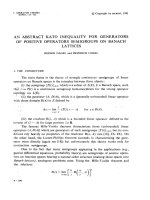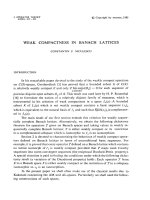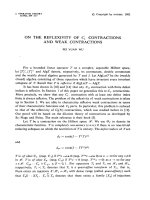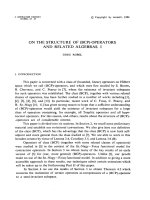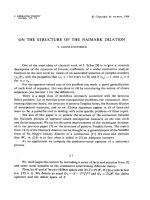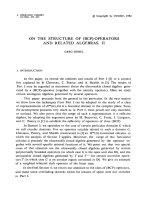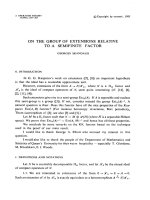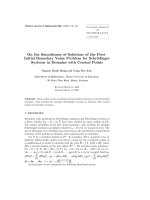Báo cáo toán học: "On the number of permutations admitting an m-th root" pptx
Bạn đang xem bản rút gọn của tài liệu. Xem và tải ngay bản đầy đủ của tài liệu tại đây (230.29 KB, 12 trang )
On the number of permutations
admitting an m-th root
Nicolas POUYANNE
D´epartement de math´ematiques
Universit´e de Versailles - Saint-Quentin
45, avenue des Etats-Unis
78035 Versailles Cedex
Submitted: August 28, 2001; Accepted: December 20, 2001.
MR Subject Classification: Primary 05A15, 05A16; Secondary 68W40
Abstract
Let m be a positive integer, and p
n
(m) the proportion of permutations of the
symmetric group
n
that admit an m-th root. Calculating the exponential
generating function of these permutations, we show the following asymptotic
formula
p
n
(m) ∼
n→+∞
π
m
n
1−ϕ(m)/m
,
where ϕ is the Euler function and π
m
an explicit constant.
1. Introduction
The question consists in estimating the number of permutations of the symmetric
group
n
which admit an m-th root when n is large. Tur´an gave an upperbound when
m is a prime number [Tu] and Blum found an asymptotically equivalent form for m =2
[Bl]. In the general case, Bender applied a theorem of Hardy, Littlewood and Karamata
to the exponential generating function of these permutations to obtain an asymptotic
equivalent of the partial sums of the required numbers [Be]. In [BoMcLWh], it is shown
that the sequence tends monotonically to zero in the case when m is prime.
Whether a permutation of
n
admits an m-th root can be read on the partition
of n determined by the lengths of the permutation’s cycles, because the class of such
the electronic journal of combinatorics 9 (2002), #R3 1
permutations is stable under conjugacy in
n
. This characterisation, already mentioned
in [Be] is established in section 2.
The computation of the exponential generating function (EGF) P
m
of these per-
mutations follows from the preceding result. This EGF splits in a natural way as a
product of two others EGF:
P
m
= C
m
× R
m
.
Singularity analysis provides the asymptotics of the coefficients of C
m
=
n
c
n
(m)X
n
because C
m
has a finite number of algebraic singularities on its circle of convergence.
This asymptotics turns to be of the following form
c
n
(m) ∼
n→+∞
κ
m
n
1−
ϕ(m)
m
,
where κ
m
is an explicit constant and ϕ the Euler function. This formula was already
established in [BoGl] only when m is a prime number.
On the contrary, the singularities of R
m
=
n
r
n
(m)X
n
form a dense subset of its
circle of convergence; this prevents transfer theorems to apply to R
m
and to the whole
series P
m
. Nevertheless, the series with positive coefficients
n
r
n
(m) converges. Now,
since
p
n
(m)
c
n
(m)
=
n
k=o
c
n−k
(m)
c
n
(m)
r
k
(m),
and since c
n−k
(m)/c
n
(m) tends to 1 as n tends to infinity for every k, the asymptotics
of the p
n
(m) will follow from an interchange of limits.
Lebesgue’s dominated convergence theorem for the counting measure on the natu-
ral numbers does not directly apply because c
n−k
(m)/c
n
(m) is too large when k is not
far from n (if k equals n, its value is n
1−ϕ(m)/m
up to a positive factor). If the sequences
c
n−k
(m)/c
n
(m)
n
were monotonic, the result would be a consequence of Lebesgue’s
monotonic convergence theorem (for the counting measure once again). Unfortunately,
this is not the case. We approximate the c
n
(m) by the coefficients d
n
(m) of the expan-
sion in power series of the principal part D
m
of C
m
in a neighbourhood of its dominant
singularity 1. The sequences
d
n−k
(m)/d
n
(m)
n
are this time monotonic, so that
lim
n→+∞
n
k=0
d
n−k
(m)
d
n
(m)
r
k
(m)=
n≥0
r
n
(m).
Now, the approximation of the c
n
(m)bythed
n
(m) is good enough to ensure the
application of dominated convergence theorem; this last fact implies the announced
result.
In an appendix, we give an explicit formula giving the number c
n
(m) ×n!ofper-
mutations of
n
whose canonical decomposition has only cycles of length prime to m
(these permutations are m-th powers).
the electronic journal of combinatorics 9 (2002), #R3 2
2. What do es an m-th power look like in
n
?
Every permutation has a canonical decomposition (unique up to order) as a product
of cycles of disjoint supports. These cycles commute. Therefore, a permutation is an
m-th power if and only if it is a product of m-th powers of cycles with disjoint supports.
Then, it suffices to check what the m-th power of a cycle looks like.
Lemma. The m-th power of a cycle of length l is a product of gcd(l, m) cycles of
length l/ gcd(l, m) with disjoint supports.
In algebraic terms, this lemma can be understood in the following way: if c is a cycle
of length l, the order of the element c
m
in the symmetric group is l/ gcd(l, m).
In order to establish the shape of an m-th power of
n
, let us introduce the notation
l
∞
∧ m:ifl and m are integers, gcd(l
n
,m) does not depend on n, provided n is large
enough; l
∞
∧ m is defined as this common value of gcd(l
n
,m), n 1. In terms of
decomposition in prime factors, l
∞
∧m is the part of m having a common divisor with
l:letm = ±
p
v
p
(m)
be the decomposition of m in primes, the products ranges over
all primes numbers p, the valuations v
p
(m) are nonnegative integers, almost all of them
are zero. Then, l
∞
∧ m =
p
v
p
(m)
where the product ranges over all primes p such
that p divides l. At last, one can see the number l
∞
∧ m as the least positive divisor d
of m such that l and m/d are coprimes.
Proposition. A permutation σ ∈
n
has an m-th root if and only if for every
positive integer l,thenumberofl-cycles in the canonical decomposition of σ is a multiple
of l
∞
∧ m.
Proof. Let δ = l
∞
∧ m.Thenδ divides m,andgcd(m/δ, l) = 1. For every positive
integer k, with the help of the lemma, a product of kδ cycles with disjoint supports
is the m-th power of a cycle of length lkδ. Doing this for every l, one sees that the
condition is sufficient. Now, let c be a cycle of length k. Then, thanks to the lemma, c
m
is the product of gcd(k, m)cyclesoflengthl = k/ gcd(k,m). To catch the necessity of
the condition, it is enough to show that gcd(k, m) is a multiple of δ, i.e. that for every
prime p, one has v
p
(gcd(k, m)) ≥ v
p
(δ). It follows from the definition of l
∞
∧ m that
v
p
(δ)=
0ifp divides gcd(l, m)
v
p
(m)ifp does not divide gcd(l, m).
Suppose that p is a prime divisor of gcd(l, m). In particular, v
p
(l) = 0 Then, v
p
(m) <
v
p
(k)sincev
p
(l)=v
p
(k) − min{v
p
(m),v
p
(k)}. This implies that v
p
(gcd(k, m)) =
v
p
(m)=v
p
(δ). On the other hand, if the prime p does not divide gcd(l, m), then
v
p
(δ)=0≤ v
p
(gcd(k, m)) and the proof is complete.
Examples. 1: In the case where m is a prime number, the recipe to build an m-th
power in
n
is the following: compose arbitrarily cycles of length not divisible by m
with groups of m cycles of same length divisible by m (all cycles with disjoint supports).
the electronic journal of combinatorics 9 (2002), #R3 3
2: The notations for partitions are the standard ones. If the partition associated
to a permutation σ is (2
6
, 3
27
, 4
2
, 5, 6
18
, 7
2
), then σ is the 18-th power of a permutation
whose partition is (4
3
, 5, 7
2
, 8, 27
3
, 104). In general, a permutation admits many m-th
roots, which do not have necessarily the same partition.
3. The exponential generating function of the m-th powers
We adopt the following notations :
P
m
=
n≥0
p
n
(m)X
n
C
m
=
n≥0
c
n
(m)X
n
R
m
=
n≥0
r
n
(m)X
n
.
P
m
∈ Q[[X]] is the exponential generating function (EGF, formal series) of the
m-thpowersinthegroups
n
. This means that the number of m-thpowersin
n
is
p
n
(m)×n!foreachn.Inthesameway,C
m
is the EGF of the permutations having only
cycles of length prime to m in their canonical decomposition (they admit a m-th root)
and R
m
the EGF of the rectangular m-th powers, that is the m-th powers with only
cycles of length having a common factor with m (the adjective rectangular is chosen
because of the form of the Ferrers diagram associated to such a permutation : a sequence
of rectangular blocks of height greater than 1).
Now, the standard way to compute these series [FlSe] leads to the following expres-
sions, according to the previous proposition:
P
m
= C
m
× R
m
=
l≥1
e
l
∞
∧m
X
l
l
. (1)
In the last formula, l
∞
∧ m is defined in 2- and e
d
denotes the formal series (or the
entire function) defined for d ≥ 1by
e
d
(X)=
n≥0
X
nd
(nd)!
=
1
d
ζ
exp(ζX).
The last sum is extended to all d-th (complex) roots of 1. Note that for d = 1 this series
is the exponential and for d = 2 the hyperbolic cosine.
3.1. Isolating the numbers l prime to m, one finds
C
m
=exp
l≥1
gcd(l,m)=1
X
l
l
. (2)
the electronic journal of combinatorics 9 (2002), #R3 4
If the decomposition into prime numbers of m is m = p
α
1
1
p
α
r
r
with all α
i
greater or
equal to one, let q(m)=p
1
p
r
be the quadratfrei radical*ofm (a positive integer is
said to be quadratfrei if and only if it has no square factor). For conciseness, we shall
write q in place of q(m) if the situation is unambiguous. Formula (2) shows that
C(m)=C(q).
If m is the power of a prime number, gcd(k, m) = 1 if and only if k is not divisible by
the prime q, which gives the expression C
m
=
q
√
1 − X
q
/(1 − X). Furthermore, if p is
a prime number and q a quadratfrei number prime to p, formula (2) shows that
C
pq
(X)=C
q
(X) ×C
q
(X
p
)
1/p
. (3)
We note µ the M¨obius function on the positive integers, defined by µ(m)=0ifm
has a square prime factor, and µ(q)=(−1)
r
if q is a quadratfrei number with r prime
factors (in particular, µ(1) = 1). The function µ is multiplicative in the following sense
:ifm
1
and m
2
are coprime numbers, then µ(m
1
m
2
)=µ(m
1
)µ(m
2
) (see [HaWr]).
Proposition. For every positive m, the EGF of the permutations having only
cycles of length prime to m in their canonical decomposition is
C
m
=
k|m
1 − X
k
−µ(k)/k
Proof. Induction with formula (3).
Note that one can write the proposition with the product being extended only to
all divisors of the quadratfrei radical q of m. Indeed, only the quadratfrei divisors of m
have a non trivial contribution.
3.2. The contribution of the rectangular m-th powers to the series P
m
is the
product extended to the l which have a common factor with m, i.e.
R
m
=
l≥1
gcd(l,m)=1
e
l
∞
∧m
X
l
l
. (4)
* In terms of commutative algebra, the radical of an ideal I is the set of all elements
of the ring some positive power of which belongs to I; in the present situation, q(m)is
the positive generator of the radical of the ideal of Z generated by m.
the electronic journal of combinatorics 9 (2002), #R3 5
4. Main theorem
We now aim to calculate an asymptotic equivalent of the coefficients of P
m
=
C
m
R
m
. Singularity analysis will allow us to establish such an asymptotics for the coef-
ficients of C
m
, because the radius of convergence of the associated analytic function it
defines is 1, with a finite number of algebraic singularities on the unit circle. Unfortu-
nately, the series R
m
admits the unit circle as a natural boundary: the singularities of
R
m
form a dense subset of the unit circle.
The argument given to reach the desired asymptotics uses the convergence of the
series of coefficients of R
m
, and a combination of monotonic and dominated convergences
round C
m
, together with a new occurence of singularity analysis.
4.1. Convergence of the series
n
r
n
(m)
The infinite product
R
m
(1) =
l≥1
gcd(l,m)=1
e
l
∞
∧m
1
l
converges because its general term is 1 +
O
(1/l
2
)asl tends to infinity.
Moreover, e
d
(X
l
/l)=1+
1
l
d
d!
X
ld
+ ···, which shows that just a finite number of
factors of the infinite product R
m
are enough to calculate the n-th coefficient r
n
(m)
(roughly speaking, one needs less than the first n/2 terms of the product).
If t is a positive integer, let R
t
m
=
r
t
n
(m)X
n
be the product of the first t terms of
the product R
m
. The series R
t
m
has an infinite radius of convergence; in particular, the
series
n
r
t
n
(m)convergestoR
t
m
(1). Then, all terms being nonnegative, if t is greater
than n/2, one has successively
n
k=0
r
k
(m)=
n
k=0
r
t
k
(m) ≤
+∞
k=0
r
t
k
(m)=R
t
m
(1) ≤ R
m
(1).
The last inequality is due to the fact that the e
d
are greater than 1 on the nonnegative
real numbers. Since the terms r
n
(m) are all positive, the series
n
r
n
(m)converges
and thanks to Abel’s theorem*, one has at last
n≥0
r
n
(m)=R
m
(1). (5)
Remark. The series R
m
admits the unit circle as a natural boundary. We illus-
trate this phenomenon on the particular case where m = 2. The general case, more
complicated to write, is conceptually of the same kind.
* We refer to the following theorem of Abel: if the series
a
n
converges, then the
power series
a
n
z
n
is uniformly convergent on [0, 1].
the electronic journal of combinatorics 9 (2002), #R3 6
For m = 2, the series is
R
2
=
n≥1
cosh
X
2n
2n
=exp
m≥1
(−1)
m−1
τ
m−1
m2
2m+1
Li
2m
(X
4m
)
, (6)
where Li
n
(X)=
X
k
/k
n
is the n-th polylogarithm and τ
m
are the tangent numbers,
defined by the expansion tan X =
τ
m
X
2m+1
.Then-th polylogarithm has a singular-
ity at 1, with principal part (1 −z)
n−1
log 1/(1 −z) up to a factor. Thus every primitive
4m-th root of unity ζ is a singularity of R
2
with principal part (1 −z/ζ)
2m−1
log 1/(1 −
z/ζ)uptoafactor,sothatR
2
is singular at a dense subset of points on the unit circle.
4.2. Asymptotics of the c
n
(m)
We use a restricted notion of order of a singularity: we will say that an analytic
function f has order α ∈ R \ Z
−
at its (isolated) singularity ζ if
f(z)=
c
1 −
z
ζ
α
1+
O
(z − ζ)
in a neighbourhood of ζ which avoids the ray [ζ,+∞[, where c is a non zero constant
(c is the value at ζ of the function z → (1 −
z
ζ
)
α
f(z)).
All the singularities of C
m
are on the unit circle : they are the q-th roots of
unity, where q is the quadratfrei radical of m. The order of the singularity 1 is clearly
µ(k)/k, where the sum extends to all divisors of q. Let ϕ be the Euler function, i.e.
ϕ(q) is the number of all positive integers less or equal to q and prime to q. Because of
the M¨obius inversion formula (see [HaWr]), since q =
ϕ(k)wherek ranges over all
divisors of q, one finds
µ(k)/k = ϕ(q)/q. An elementary calculation of the same kind,
using the multiplicativity of the arithmetical functions ϕ and µ leads to the following
result.
Lemma. If ζ is a primitive k-th root of unity (where k divides q), then C
m
has at
ζ a singularity of order
µ(k)
ϕ(k)
ϕ(q)
q
.
Note once more that one could state this result without the use of q, writing directly m
instead of q. Indeed, µ is zero on non-quadratfrei numbers, and ϕ(q)/q = ϕ(m)/m.
Proposition. For every positive integer m,thenumberc
n
(m)×n! of permutations
of
n
having only cycles of length prime to m in their canonical decomposition satisfies
c
n
(m) ∼
n→+∞
κ
m
n
1−
ϕ(m)
m
,
where κ
m
is the following constant depending only on the quadratfrei radical q of m
κ
m
=
1
Γ
ϕ(m)
m
k|m
k
−
µ(k)
k
.
the electronic journal of combinatorics 9 (2002), #R3 7
Proof. C
m
defines an analytic (single-valued) function in any simply connected domain
that avoids its singularities. The lemma shows that the singularity of C
m
at 1 determines
alone the asymptotics of c
n
(m) via transfer theorem *. The constant κ
m
× Γ
ϕ(m)
m
is
the value at 1 of the function z → (1 − z)
ϕ(m)/m
C
m
(z).
For a formula giving the exact value of c
n
(m), see the appendix. Figure 1 shows
the first thousand values of kappa, with m on the x-axis and κ
m
on the y-axis.
0.4
0.6
0.8
1
1.2
0 200 400 600 800 1000
Figure 1: The function m → κ
m
4.3. Statement and pro of of the main theorem
The situation is the following: we look for the asymptotics of the coefficients
p
n
(m) of the formal series P
m
= C
m
R
m
where the coefficients c
n
(m)areequivalent
to n
−1+ϕ(m)/m
up to a constant factor, and the series of coefficients r
n
(m) converges.
* By transfer theorem, we mean analysis of singularities that consists in deducing the
asymptotics of the coefficients of a power series from the local analysis of its singularities
when they involve only powers and logarithms. For a detailed study, see [FlSe].
the electronic journal of combinatorics 9 (2002), #R3 8
Theorem. Let m be a positive integer. The number p
n
(m) × n! of permutations
of
n
which admit a m-th root satisfies
p
n
(m) ∼
n→+∞
π
m
n
1−
ϕ(m)
m
where π
m
is the positive constant
π
m
= κ
m
R
m
(1) =
1
Γ
ϕ(m)
m
k|m
k
−
µ(k)
k
l≥1
gcd(l,m)=1
e
l
∞
∧m
1
l
.
Proof. For simplicity, we note p
n
= p
n
(m), and similarly for c
n
and r
n
. We deduce
from the formula P
m
= C
m
R
m
that p
n
=
c
n−k
r
k
,wherek ranges over {0, ,n}.
Since c
n−k
/c
n
tends to 1 as n tends to infinity for every k (see the asymptotics of c
n
),
it is enough to show that the following interchanging of limits is valid:
lim
n→+∞
n
k=0
c
n−k
c
n
r
k
=
n≥0
r
n
.
Let D
m
be the series D
m
= κ
m
×Γ(ϕ(m)/m)×(1−X)
−ϕ(m)/m
=
n≥0
d
n
X
n
,principal
term of the series C
m
in a neighbourhood of 1 (see proof of the previous proposition).
For each integer k, the sequence (d
n−k
/d
n
)
n
decreases (compute it explicitely, d
n
is a
generalised binomial number up to a factor) and converges to one. Then, by monotonic
convergence theorem,
lim
n→+∞
n
k=0
d
n−k
d
n
r
k
=
n≥0
r
n
.
On the other hand, the formal series C
m
− D
m
defines a function analytic on the unit
disk, whose singularities are those of C
m
except 1 which becomes of order ϕ(m)/m −1.
If m = 1, the singularity that determines the asymptotics of its coefficient has order α
strictly less than ϕ(m)/m (the previous lemma gives α explicitely). As a consequence,
1 − d
n
/c
n
tends to zero as n tends to +∞. In particular, there exist two positive
constants A and B such that
∀n ≥ 0,A≤
d
n
c
n
≤ B.
Then, for all n and k (with k ≤ n), one has
c
n−k
c
n
≤
B
A
d
n−k
d
n
.
The conclusion follows now from the dominated convergence theorem.
the electronic journal of combinatorics 9 (2002), #R3 9
Figure 2 shows the first thousand values of the function m → π
m
, with m on the
x-axis and π
m
on the y-axis.
0.4
0.6
0.8
1
1.2
0 200 400 600 800 1000
Figure 2: The function m → π
m
Remarks.
i) When m is the power of a prime number q, there is another way to catch the in-
terchange of limits because one can explicitly write the coefficients c
n
(m)=c
n
(q)as
products and quotients of integers (see section 5- : under this assumption, b
n
(q)equals
c
n
(q)). It is just a matter of elementary computation to see that for every k,the
“congruence subsequences” of c
n−k
(q)/c
n
(q) are monotonic :
∀k ≥ 0, ∀r ∈{0, ,q−1}, the sequence
c
nq+r−k
(q)
c
nq+r
(q)
n
is monotonic.
Putting together the common asymptotics these congruence subsequences give is enough
to prove the theorem.
ii) The expression of P
m
with the help of polylogarithms such as in formula (6) would
give an alternative proof of the theorem, and a way to obtain further asymptotics of the
numbers p
n
(m), using a hybrid method of singular analysis and of Darboux’s method
as it is described in [FlGoPa].
the electronic journal of combinatorics 9 (2002), #R3 10
5. Appendix
Let b
n
(m)×n! be the number of permutations of
n
which admit no cycle of length
divisible by m in their canonical decomposition. Calculating the exponential generating
function of these permutations leads to a recurrence formula for the b
n
(m); finally, one
finds
b
n
(m)=
1≤k≤n
m|k
1 −
1
k
(see [BeGo]). One can calculate these numbers with the induction formula:
b
n
(m)=b
n−1
(m)ifn/∈ mN
∗
b
n
(m)=b
n−1
(m)(1 −
1
n
)ifn ∈ mN
∗
If B
m
(resp. C
m
) denotes the set of all permutations (of any
n
) which admit no cycle of
length divisible by m (resp. having only cycles of length prime to m) in their canonical
decomposition, then C
m
=
B
d
, where the union is extended to all divisors d of q
greater than or equal to 2. Once more, q denotes the quadratfrei radical of m.The
sieve formula gives #(C
m
)=
−µ(d)#(B
d
), the sum being extended to the same d as
before; µ is the M¨obius function. This implies the following result.
Proposition. The number c
n
(m) × n! of permutations of
n
having only cycles
of length prime to m satisfies
c
n
(m)=
d≥2
d|m
− µ(d)b
n
(d)=
d≥2
d|m
− µ(d)
k∈dZ
1≤k≤n
1 −
1
k
.
6. Aknowledgements
Je remercie tout particuli`erement Abdelkader Mokkadem et Jean-Fran¸cois Marckert
d’avoir suscit´e puis soutenu mes premiers pas sur le sujet, ainsi que Philippe Flajolet
pourm’avoirpermisdemerep´erer dans le paysage des disciplines qui lui sont connexes.
References
[Be] E. A. Bender, Asymptotics methods in enumeration, SIAM Rev. 16 (1974), 485-
515.
[BeGo] E. A. Bertram and B. Gordon, Counting special permutations, European J.
Combin. 10(3) (1989), 221-226.
[Bl] J. Blum, Enumeration of the square permutations in S
n
, J. Combin. Theory Ser.
A17 (1974), 156-161.
the electronic journal of combinatorics 9 (2002), #R3 11
[BoGl] E.D. Bolker and A.M. Gleason, Counting permutations, J. Combin. Theory Ser.
A29(2) (1980), 236-242.
[BoMcLWh] M. B´ona, A. McLennan and D. White, Permutations with roots, Random
Structures & algorithms 17(2) (2000), 157-167.
[FlGoPa] P. Flajolet, X. Gourdon, D. Panario, The complete analysis of a polynomial
factorization algorithm over finite fields, J. of Algorithms,toappear.
[FlOd] P. Flajolet and A.M. Odlyzko, Singularity analysis of generating functions, SIAM
Journal on Discrete Mathematics 3(2) (1990), 216-240.
[FlSe] P. Flajolet and R. Sedgewick, The average case analysis of algorithms: complex
asymptotics and generating functions, INRIA research report 2026 (1993).
[HaWr]G.H.HardyandE.M.Wright,An introduction to the theory of numbers,Oxford
Science Publications.
[Tu] P. Tur´an, On some connections between combinatorics and group theory, Colloq.
Math. Soc. J´anos Bolyai, P. Erd¨os, A. R´enyiandV.T.S´os, eds., North Holland,
Amsterdam (1970), 1055-1082.
the electronic journal of combinatorics 9 (2002), #R3 12


